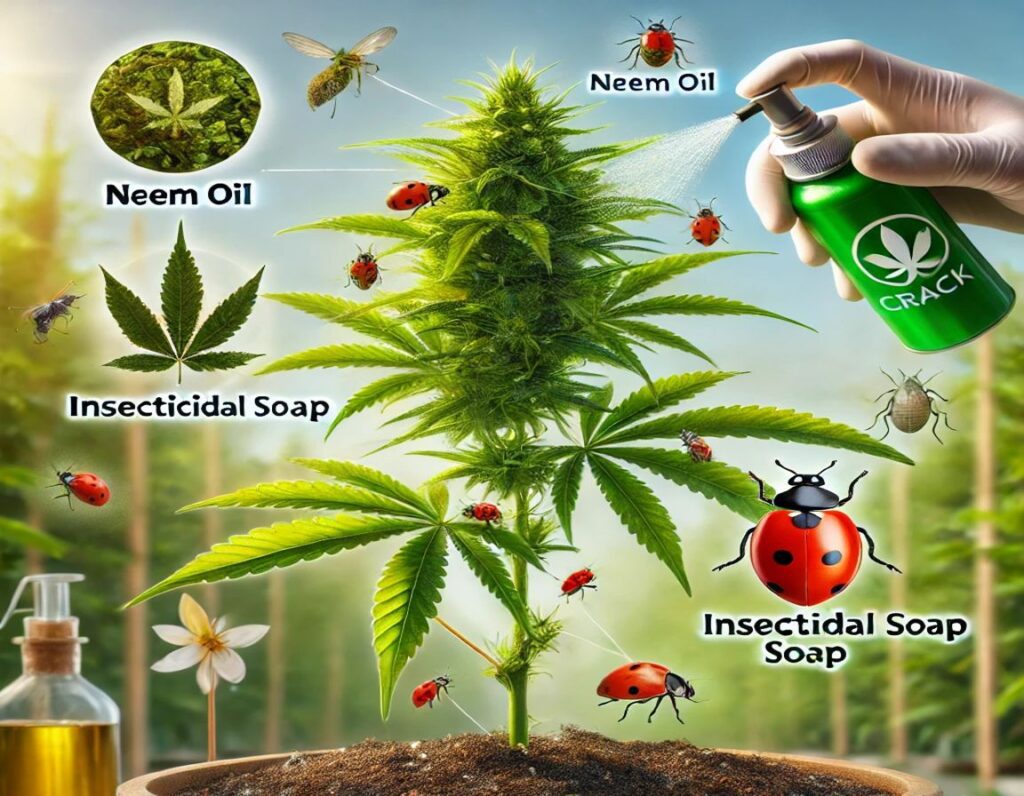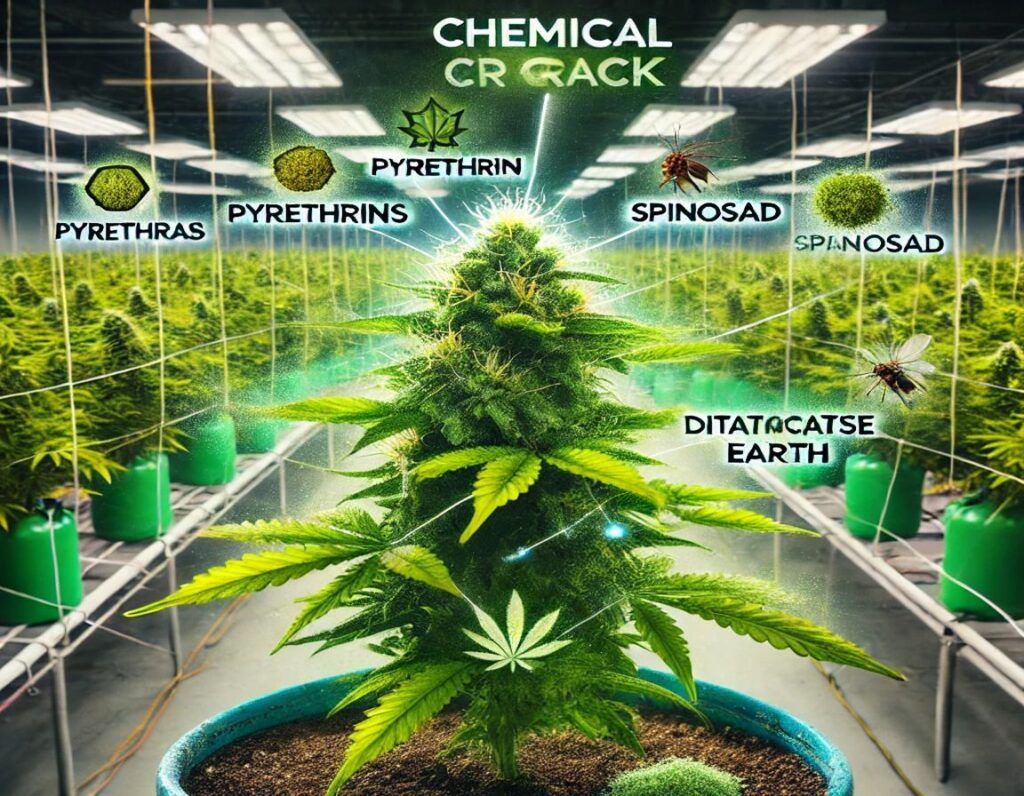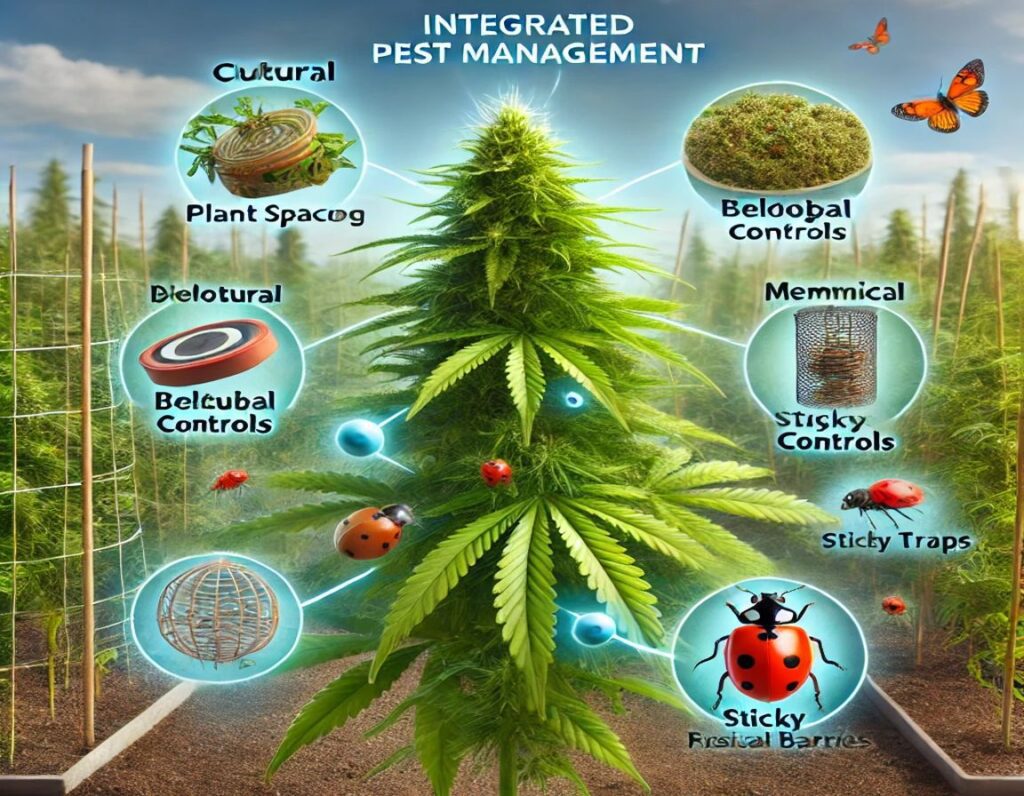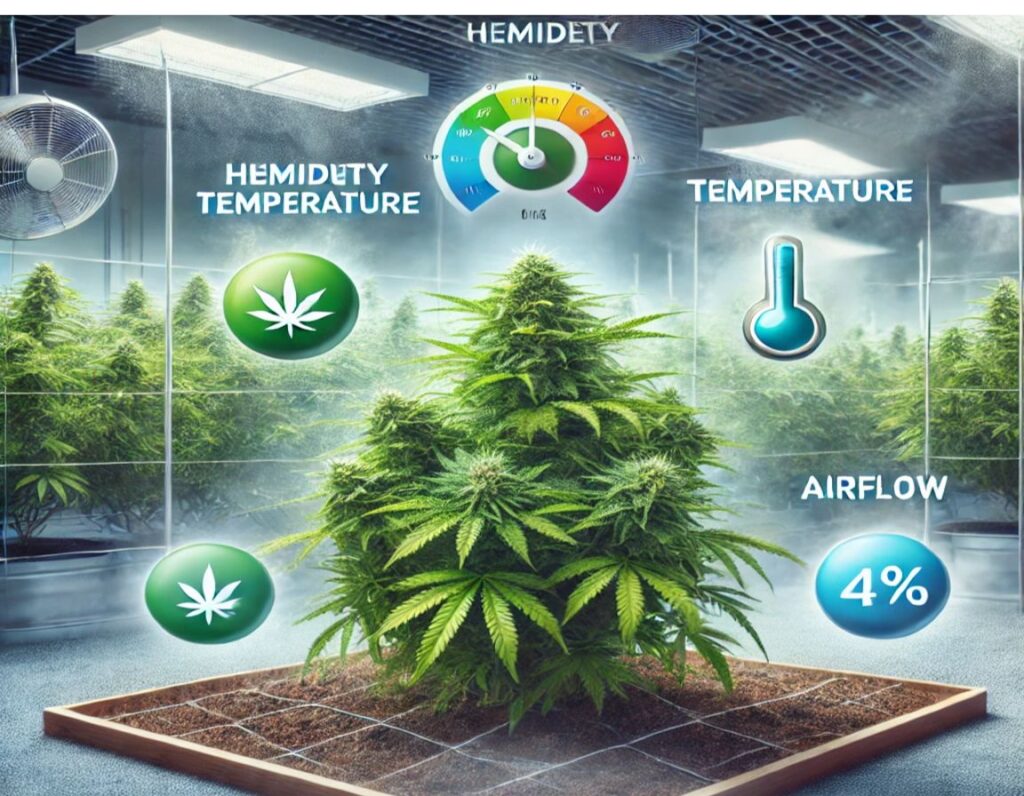
Effective pest management starts with recognizing the pests that are most likely to affect your Green Crack plants. In the USA, several pests are common across cannabis gardens, both indoors and outdoors. Below are some of the most prevalent pests and the damage they can cause if left unchecked:
These tiny, sap-sucking arachnids are difficult to see with the naked eye, but their damage is unmistakable. They prefer hot, dry environments and often go undetected until they’ve already inflicted considerable damage. Spider mites pierce the plant’s cells and suck out the contents, leading to tiny yellow or white spots on the leaves. Severe infestations result in webbing between leaves and stems, eventually causing leaf drop and reduced plant vigor. Spider mites can rapidly decimate a crop, especially if left untreated in an indoor grow environment.
These soft-bodied insects are typically found on the undersides of leaves, where they feed on plant sap. Aphids multiply quickly and can cause leaf curling, yellowing, and stunted growth. Their feeding also weakens the plant, making it more susceptible to disease. Aphids excrete a sugary substance called honeydew, which encourages the growth of sooty mold on the leaves, further hindering photosynthesis and reducing plant health.
Thrips are small, slender insects that scrape the plant surface to feed on its fluids. Their feeding results in silvery or bronze streaks on leaves and can cause deformed growth in severe cases. Thrips are especially problematic during the vegetative and flowering stages, as they can cause significant stress, stunting plant growth and damaging flowers.
These small, winged insects are closely related to aphids and cause similar damage by sucking sap from the undersides of leaves. Like aphids, whiteflies excrete honeydew, promoting mold growth. They are particularly troublesome in indoor environments, where they can reproduce quickly.
Routine inspections are critical to identifying these pests early. It is essential to regularly examine both the upper and lower surfaces of leaves, as well as the soil, for signs of pests. Catching infestations in their early stages makes them much easier to manage and reduces the risk of long-term damage to your plants.

Organic pest control methods are an excellent choice for growers who want to avoid using synthetic chemicals on their crops. These methods prioritize natural solutions that protect the plants while preserving the overall health of the environment. Below are some of the most effective organic strategies for managing pests in your Green Crack garden:
Neem oil is a widely used natural pesticide that effectively disrupts the life cycle of many pests, including aphids, spider mites, and whiteflies. The oil prevents pests from feeding, laying eggs, and molting. To use neem oil, mix it with water and apply it directly to the leaves, ensuring both the tops and undersides are covered. Repeat applications may be necessary, particularly if pests are persistent. Neem oil is safe for plants and humans, making it a popular choice for organic growers in the USA.
Insecticidal soap works by disrupting the cell membranes of soft-bodied insects like aphids and spider mites. It dehydrates and kills pests without harming plants, making it a safe and effective option for growers. Spray insecticidal soap directly onto affected areas, paying special attention to the undersides of leaves. Insecticidal soap is especially useful in combination with other organic pest control methods, as it can reduce pest populations quickly.
Releasing beneficial insects into your grow space is an excellent long-term pest control solution. Predatory insects such as ladybugs, lacewings, and predatory mites feed on common pests like aphids, spider mites, and thrips, keeping their populations in check. Ladybugs, in particular, can consume hundreds of aphids in a single day, making them a valuable ally in your garden. Introducing these beneficial insects early in the growing season can help prevent infestations before they start.
Many USA-based cannabis growers report that using organic methods, particularly a combination of neem oil, insecticidal soap, and beneficial insects, is effective for managing pests without resorting to harsh chemicals. These methods are especially effective in small-scale grows, where environmental conditions can be controlled more easily.

In large-scale cannabis operations, where pest infestations can spread rapidly and cause significant damage, chemical pesticides may be necessary to keep pests under control. However, it is important to select products that are safe for cannabis and follow local regulations regarding pesticide use. Below are some chemical pest control options that are commonly used in cannabis farming:
Pyrethrins are natural insecticides derived from chrysanthemum flowers. They attack the nervous systems of insects, making them highly effective against a wide range of pests, including aphids, thrips, and whiteflies. Pyrethrins are often used in combination with other synthetic chemicals to increase their effectiveness. They break down quickly in sunlight, reducing their impact on the environment and making them a safer option for plants.
Spinosad is a naturally occurring compound that is effective against thrips, spider mites, and other pests. It works by damaging the nervous system of the pest, causing paralysis and death. Spinosad is approved for organic farming in many regions, including the USA, and is often used in both organic and conventional farming. It is safe for use on cannabis plants, but care should be taken to follow proper application guidelines.
Diatomaceous earth is a natural powder made from fossilized diatoms, a type of algae. It works by physically damaging the exoskeletons of insects, causing them to dehydrate and die. Diatomaceous earth is non-toxic to humans and pets and can be applied to the soil around your plants to deter crawling pests. While it is less effective against airborne pests like whiteflies, it is an excellent option for controlling pests that reside in the soil, such as root aphids.
Chemical pest control is often necessary in larger grows where infestations can become widespread quickly. However, it is important to follow the manufacturer’s guidelines and ensure that any chemical products used are approved for use on cannabis. In addition, it’s critical to comply with state and local regulations regarding pesticide use on cannabis crops.

Integrated Pest Management (IPM) is a holistic approach to pest control that combines several strategies to create a more sustainable, long-term solution to pest problems. IPM aims to reduce the reliance on chemical pesticides by making the growing environment less conducive to pests.
Healthy cultural practices are the foundation of IPM. This includes properly spacing plants to improve airflow, removing dead or infected plant material, and rotating crops to disrupt the pest life cycle. These practices help create an environment that is less favorable to pests and reduces the need for intervention.
Beneficial insects play an important role in IPM by naturally controlling pest populations. Predators such as ladybugs, lacewings, and predatory mites can keep pests like aphids and spider mites in check without the need for chemicals.
Physical barriers such as row covers, insect-proof screens, and sticky traps can prevent pests from accessing your plants. Regularly pruning and removing infested leaves also helps limit the spread of pests within your garden.
Many cannabis growers in the USA have adopted IPM as their primary pest control strategy, as it promotes sustainable farming practices and reduces the need for synthetic chemicals.

The environment plays a significant role in pest management, and controlling factors such as humidity, temperature, and airflow can make your grow space less hospitable to pests. Managing these factors is particularly important in indoor growing environments, where pests can spread rapidly.
Many pests, such as spider mites, thrive in low-humidity environments. Maintaining humidity levels between 40-60% helps discourage these pests while promoting healthy plant growth. For outdoor grows, monitoring weather conditions and adjusting watering schedules accordingly can help maintain optimal humidity levels.
Consistent temperature control is essential for preventing plant stress, which can make them more vulnerable to pests. Maintaining temperatures between 70-85°F during the day and slightly cooler temperatures at night will support healthy growth and deter pest activity. In indoor grows, use heating or cooling systems to maintain consistent temperatures.
Proper airflow prevents stagnant air, which can create an ideal environment for pests and mold. Fans and ventilation systems should be used to keep the air circulating around your plants. Improved airflow also strengthens the plants, making them more resistant to pests.
By optimizing environmental controls, you can significantly reduce the likelihood of infestations and ensure your Green Crack plants grow in optimal conditions.
Identifying pests such as spider mites, aphids, thrips, and whiteflies early is crucial to preventing large-scale infestations. Organic pest control methods, including neem oil, insecticidal soap, and beneficial insects, offer effective and environmentally friendly solutions for small-scale grows. In larger-scale operations, chemical pesticides like pyrethrins, spinosad, and diatomaceous earth may be necessary but must be used in accordance with local laws and proper guidelines. Integrated Pest Management (IPM) combines cultural, biological, and mechanical strategies to manage pests sustainably, reducing the need for chemical interventions. Lastly, environmental factors like humidity, temperature, and airflow should be carefully managed to prevent pest outbreaks and support overall plant health.
Common pests include spider mites, aphids, thrips, and whiteflies, all of which can cause significant damage if not controlled early.
Yes, neem oil is a highly effective organic pesticide that works well against a range of pests, including aphids and spider mites.
IPM is a comprehensive pest control strategy that combines biological, cultural, and mechanical methods to manage pest populations sustainably.
Certain chemical pesticides, like pyrethrins and spinosad, are safe for use on cannabis plants, but it’s important to follow all regulations and application guidelines.
By controlling environmental factors such as humidity, temperature, and airflow, you can create a less favorable environment for pests indoors.
We ship and deliver world wide via USPS and various couriers.
We offer a wide range of secure and anonymous online payment options.
We care about you, our customer. Please contact us with any questions or concerns.
Find out more about the benefits of being a loyal and regular customer.
WE ARE EVERY GROWERS ONE STOP SHOP TO ACQUIRE PREMIUM CANNABIS SEEDS FOR SALE IN THE USA, CANADA AND AUSTRALIA

Farmers Lab Seeds 2024, | All Right Reserved
Seeds are sold as novelty items, souvenirs, and collectibles. They contain 0% THC. We encourage our customers to check the legislation in their Country, State, Province, and Municipality prior to purchasing items from our store. We do not provide growing information.
All seeds are sold as hemp, and lab tested under 0.3% THC. This product is not for use by or sale to persons under the age of 21. This product should be used only as directed on the label. It should not be used if you are pregnant or nursing. Consult with a physician before use if you have a serious medical condition or use prescription medications. A Doctor’s advice should be sought before using this and any supplemental dietary product. All trademarks and copyrights are property of their respective owners and are not affiliated with nor do they endorse this product.
These statements have not been evaluated by the FDA. This product is not intended to diagnose, treat, cure or prevent any disease. Individual weight loss results will vary. By using this site, you agree to follow the Privacy Policy and all Terms & Conditions printed on this site. Void Where Prohibited by Law.